What makes an ad impossible to ignore? Why do some product descriptions make you want to buy instantly? The answer is copywriting, the skill of using words to grab attention, spark interest, and drive action.
Table of Contents
- 🤔What Is Copywriting?
- ⭐Importance of Copywriting
- 👇Types of Copywriting
- 💡Examples of Copywriting
- ✨Best Practices for Copywriting
- 🥊Copywriting vs Content Writing
- 👀Who is a Copywriter?
- ✅Skills Needed to Become a Copywriter
- How to Become a Copywriter in 7 Steps
- Conclusion
- FAQs
But, what is copywriting? In short, it’s not just about content writing; it’s about selling an idea, a product, or a service through carefully crafted words. Great copy doesn’t just sit there, it works. It speaks directly to the target audience, builds trust, and gets results. From SEO-friendly blog posts to catchy social media captions, copywriting is what turns readers into customers.
If you’ve ever wondered how brands create messages that stick, this guide will break down copywriting, its purpose, different types, best practices, and how you can get started.
🤔What Is Copywriting?
Copywriting is writing that sells. It uses words to grab attention, create interest, and make people take action. You see it in ads, websites, emails, and social media posts.
A copywriter writes with a purpose—whether it’s to get you to buy something, sign up, or click a link. Good copy is clear, engaging, and makes the reader feel something. It’s not just about nice words; it’s about the right words that work.
Think of a slogan that sticks in your head or an email that convinces you to try a product. That’s copywriting in action. It helps businesses connect with their audience and increase sales.
Great copy is simple but powerful. It speaks directly to the reader and makes them want to respond. Every successful brand uses copywriting to stand out. Without it, marketing wouldn’t work. That’s why copywriting is such a valuable skill.
⭐Importance of Copywriting
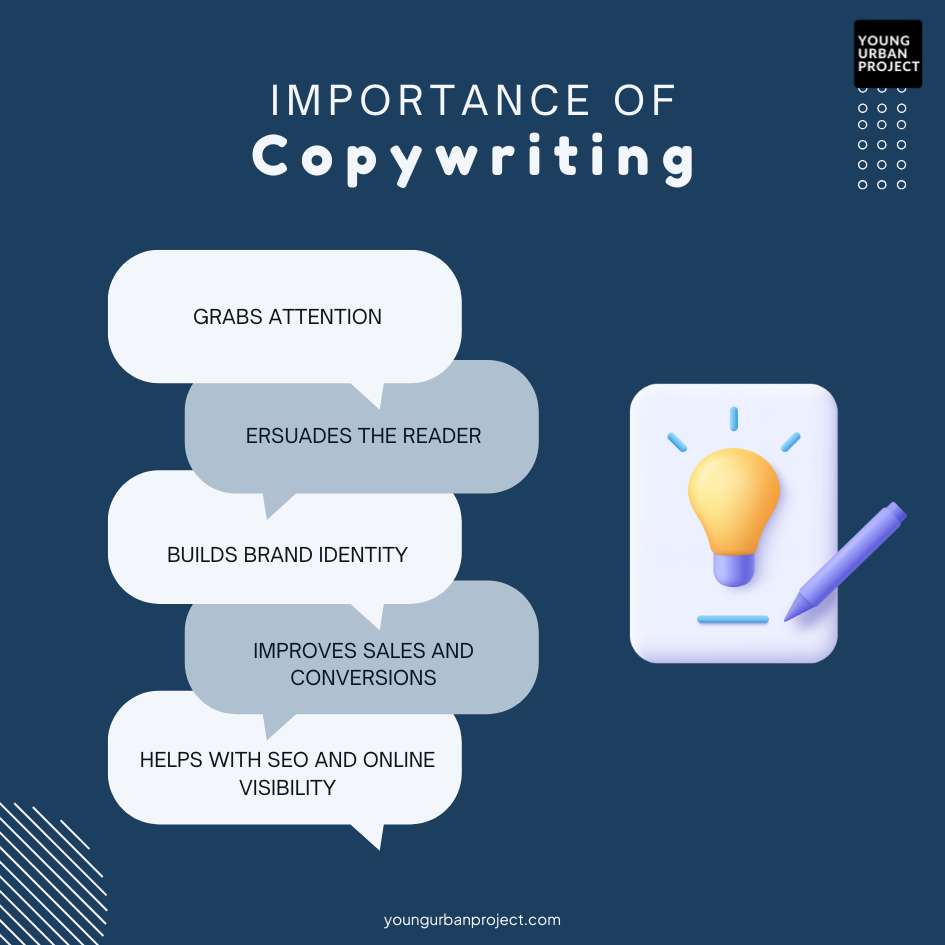
1. Grabs Attention
People see thousands of ads and messages every day. Good copywriting helps a brand stand out. A strong headline or catchy slogan makes people stop and notice. If the first few words are boring, the reader moves on. That’s why businesses need a clear, exciting, and engaging copy. Without attention, no one will read the message, and marketing efforts will fail.
2. Persuades the Reader
Copywriting isn’t just about sharing information. It’s about convincing people to take action. A copywriter understands what the audience wants and uses words to influence their decisions. Whether it’s buying a product, signing up for a service, or clicking a link, good copy makes the reader feel like they need to act. The right words can create desire, urgency, and trust.
3. Builds Brand Identity
Every brand has a personality. Some brands are fun and playful, while others are serious and professional. Copywriting shapes this personality through the words a brand uses. A consistent voice in ads, emails, and social media helps people recognize and remember the brand. Over time, this builds trust and loyalty. A strong brand voice makes businesses stand out from competitors.
4. Improves Sales and Conversions
Words can turn visitors into customers. A well-written landing page, email, or ad can convince people to make a purchase. Copywriting highlights the benefits of a product or service in a way that makes it irresistible. Instead of just listing features, good copy shows how something can solve a problem or improve the reader’s life. The right message can boost sales and increase business growth.
5. Helps with SEO and Online Visibility
In the digital world, businesses need to be found online. SEO copywriting uses keywords to help websites rank higher on search engines like Google. This means more people can discover a business when they search for related products or services. Good copy isn’t just about writing—it’s about making sure the right audience finds the content. Without SEO-friendly copy, even great products may go unnoticed.
👇Types of Copywriting
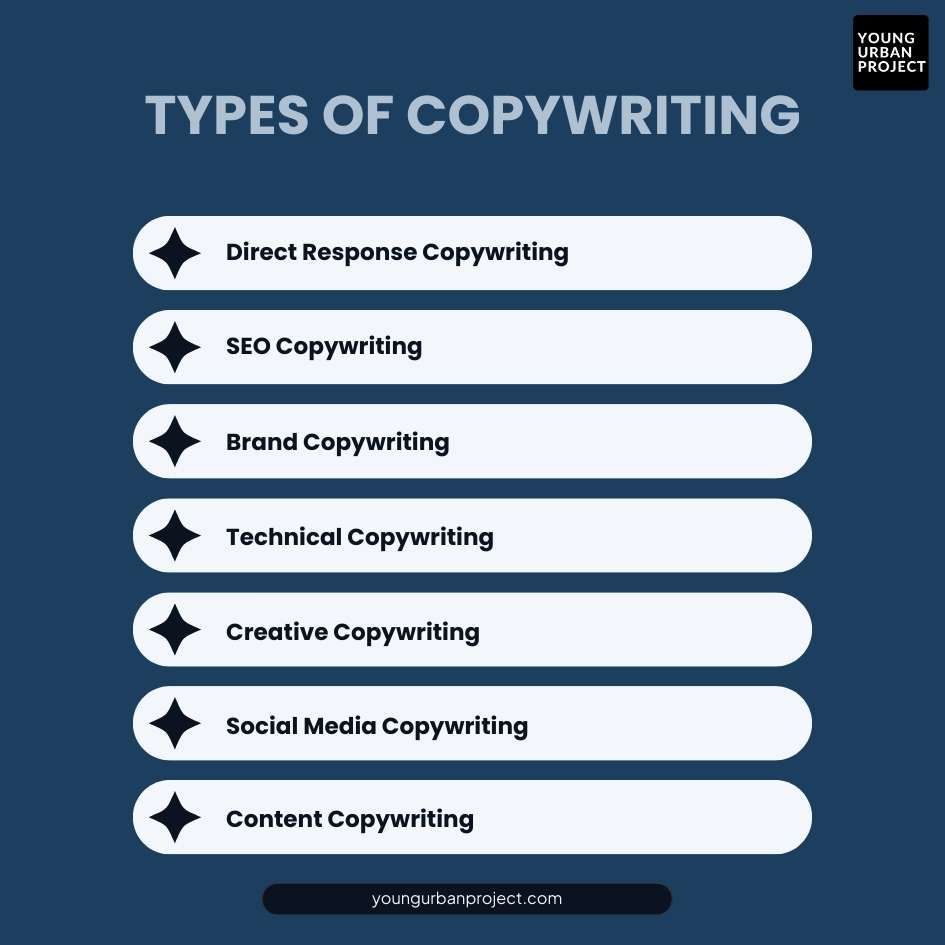
1. Direct Response Copywriting
This type aims to get an immediate action from the reader. It is used in ads, emails, and sales letters. The goal is to persuade the reader to buy, sign up, or click. It uses strong calls-to-action and clear benefits. It focuses on solving a problem quickly. Results are easy to measure, like clicks or sales.
2. SEO Copywriting
This focuses on writing content for search engines. It uses keywords to rank higher in search results. The goal is to attract organic traffic. It balances readability with keyword placement. It helps websites get more visitors. It is used in blogs, articles, and website content. Good SEO copywriting is both informative and optimized.
3. Brand Copywriting
This builds a brand’s identity and voice. It works to create a lasting impression on the audience. It is used in taglines, slogans, and brand stories. The intention is to establish a brand that sticks in people’s minds. It emphasizes emotions and values. It helps customers trust and recognize the brand. It is less about selling and more about storytelling.
4. Technical Copywriting
This explains complex information in simple terms. It is used in manuals, guides, and product descriptions. The goal is to make technical details easy to understand. It requires knowledge of the subject. It helps users use products or services correctly. It is clear, precise, and avoids jargon unless necessary.
5. Creative Copywriting
This focuses on imagination and originality. It is used in campaigns, ads, and social media. The goal is to grab attention and stand out. It uses humor, storytelling, or unique ideas. It is often visually driven. It helps brands create a strong impression. It is less formal and more engaging.
6. Social Media Copywriting
This is tailored for platforms like Facebook, Instagram, and Twitter. It is short, engaging, and conversational. The goal is to encourage likes, shares, and comments. It uses hashtags, emojis, and visuals. It connects with the audience quickly. It frequently plays a role in a broader marketing strategy. It focuses on building community and interaction.
7. Content Copywriting
This provides valuable information to the audience. It is used in blogs, articles, and eBooks. The goal is to educate or entertain. It builds trust and authority. It is less sales-focused and more informative. It helps with long-term customer relationships. It often supports other marketing efforts like SEO or social media.
💡Examples of Copywriting
1. Colgate – Clear and Trustworthy Messaging
Colgate uses simple and reassuring language in its ads and packaging. It highlights benefits like “Fights Cavities” or “Clinically Proven Protection.” The copy is direct, easy to understand, and builds trust. Colgate also uses strong calls to action, such as “Brush Twice a Day for Best Results.” This makes the message clear and encourages daily use.

2. Old Spice – Funny and Bold Advertising
Old Spice is known for its humorous and confident copy. Ads use exaggerated language to grab attention. Phrases like “Smell Like a Man, Man” or “The Man Your Man Could Smell Like” make the brand memorable. The playful tone connects with younger audiences and makes the product stand out in a crowded market.

3. Duolingo’s Push Notifications – Fun and Engaging
Duolingo uses friendly and sometimes guilt-tripping notifications to keep users engaged. Messages like “You’re so close to your goal! Don’t stop now!” or “Ouch, that was a long break! Come back to learning.” create urgency and motivation. The fun, casual tone makes learning feel less like a chore and more like a game.

4. Himalaya (India) – Natural and Benefit-Focused
Himalaya’s product descriptions focus on herbal and Ayurvedic benefits. Copy like “Enriched with Neem for Clear Skin” or “Gentle Care with Aloe Vera” makes the product’s purpose clear. The brand highlights natural ingredients and their effects, building trust among health-conscious customers. The simple, informative tone appeals to those looking for safe and effective skincare.

5. LEGO’s Instruction Manuals – Clear and Easy-to-Follow
LEGO’s manuals use minimal text and step-by-step visual instructions. This makes it easy for kids and adults to build without confusion. The advertising copy that is used, such as “Snap into place” or “Align the pieces carefully”, is short and clear. The simplicity ensures that anyone, regardless of language, can follow along and enjoy the experience.
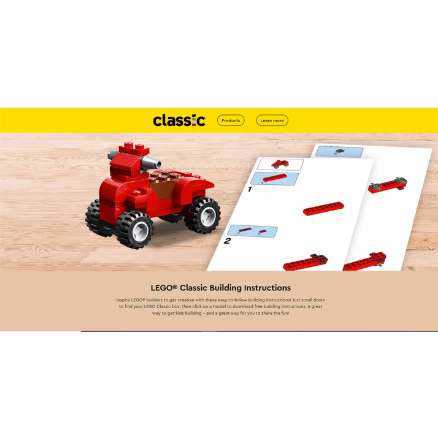
6. Airbnb – Emotional and Inclusive Copy
Airbnb’s slogan, “Belong Anywhere,” is powerful and inviting. It tells travelers that they are welcome no matter where they go. The brand uses warm, storytelling-based copy to highlight personal experiences. Instead of focusing just on bookings, Airbnb emphasizes community and connection, making it more than just a travel platform.

7. LinkedIn – Curiosity-Driven Notifications
LinkedIn’s message “Someone viewed your profile!” creates curiosity and encourages users to check their account. It plays on the natural human desire to know who is interested in them. The wording is simple but effective. By keeping it vague, LinkedIn increases engagement, making users return to the platform frequently.

✨Best Practices for Copywriting
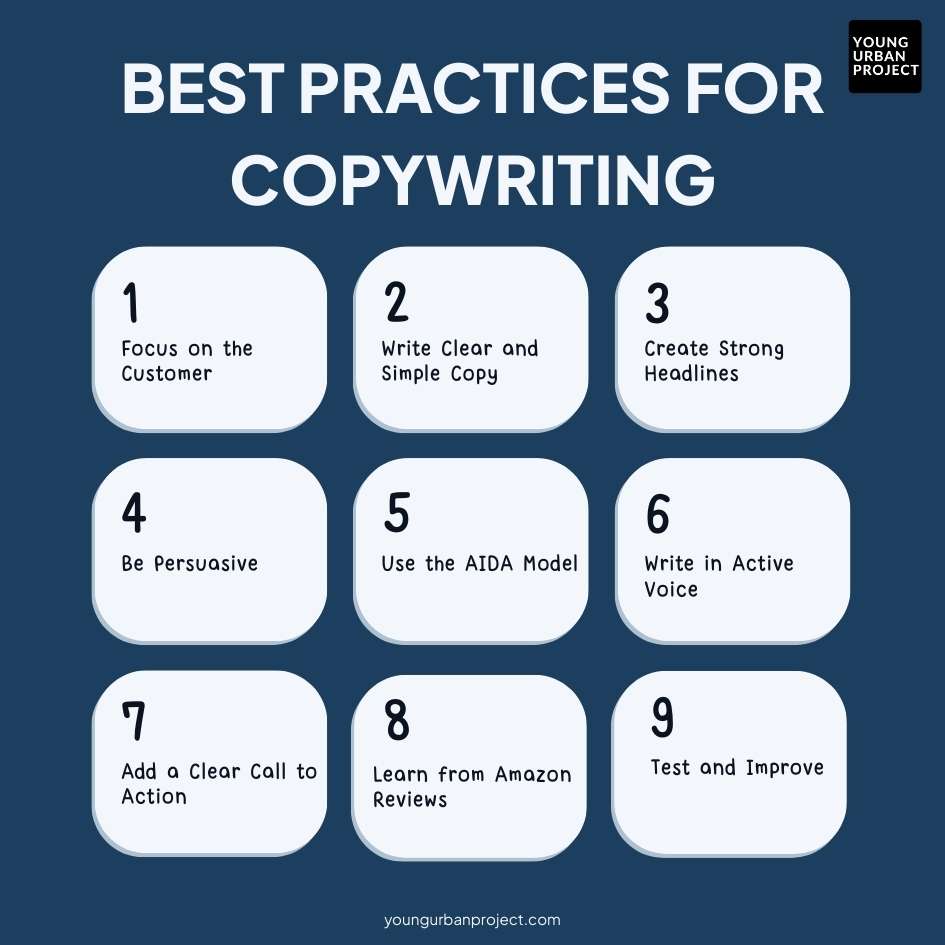
1. Focus on the Customer
Great copy is about the reader, not the writer. It should be designed to meet the customer’s demands, pain points, and wishes. Instead of listing features, show how the product or service benefits them. Speak directly to your reader by adding “you” and “your” in the message. When customers feel understood, they are more likely to trust the brand and take action.
2. Write Clear and Simple Copy
Good copy is easy to understand. Avoid complicated words and long sentences. Readers should get the message quickly without confusion. Use short sentences, simple words, and a natural tone. The priority is effective communication, not impressing anyone. If the copy is too complex, people might lose interest and stop reading. Clear writing keeps the audience engaged.
3. Create Strong Headlines
The headline is the first thing people see. It should grab attention and make them want to read more. A good headline is short, direct, and interesting. It should give a hint about what’s coming next. If the headline doesn’t catch interest, the rest of the content won’t matter. Always test different headlines to see what works best.
4. Be Persuasive
Copywriting is about convincing people to take action. Use words that create emotions and build trust. Show why the product is valuable and how it can improve their lives. Use social proof, such as reviews or testimonials, to increase credibility. The stronger the persuasion, the more likely people will buy, sign up, or take the next step.
5. Use the AIDA Model
AIDA stands for Attention, Interest, Desire, and Action. First, grab attention with a strong opening. Then, keep the reader interested with useful details. Create desire by showing benefits and solutions. Finally, encourage action with a clear call to action. This model helps structure copy in a way that leads to better conversions.
6. Write in Active Voice
Active voice makes copy strong and direct. Instead of “The product can be used to solve problems,” say “This product solves problems.” Active voice sounds more natural and engaging. It makes the message clearer and more persuasive. Passive voice can make sentences weak and confusing, so it’s best to avoid it in marketing copy.
7. Add a Clear Call to Action
Every piece of copy should guide the reader to do something. Whether it’s buying a product, signing up for a newsletter, or clicking a link, the action must be clear. Use direct words like “Buy Now,” “Sign Up Today,” or “Get Started.” If people don’t know what to do next, they might leave without taking action.
8. Learn from Amazon Reviews
Amazon reviews are a goldmine of insights. Reading customer feedback helps understand what people love or dislike about a product. This information can be used to write better, more relatable copy. Reviews reveal real pain points and desires, helping copywriters craft messages that connect with the audience’s needs.
9. Test and Improve
Copywriting is not a one-time job. It needs testing and improvement. Try different headlines, calls to action, or formats to see what works best. Use A/B testing to compare versions and track results. If something isn’t working, adjust it. The best copy comes from continuous learning and refining.
🥊Copywriting vs Content Writing
| Feature | Copywriting | Content Writing |
| Purpose | Persuades people to take action (buy, sign up, click, etc.). | Educates, informs, or entertains the audience. |
| Goal | Increases sales, conversions, or engagement. | Builds trust, brand awareness, and audience loyalty. |
| Tone | Persuasive, direct, and action-driven. | Informative, engaging, and sometimes storytelling-based. |
| Examples | Ads, sales pages, product descriptions, email marketing. | Blogs, articles, social media posts, ebooks. |
| Length | Usually short and direct. | Can be long, depending on the topic. |
| SEO Usage | Uses keywords but focuses more on conversions. | Uses SEO strategies to rank higher on search engines. |
| Writing Style | Focuses on emotions, urgency, and benefits. | Focuses on providing value, insights, and education. |
| Call to Action (CTA) | Always includes a clear CTA (e.g., “Buy Now,” “Sign Up,” “Click Here”) | May or may not have a CTA, depending on the content. |
| Examples of Platforms | Websites, landing pages, ads, emails, product packaging. | Blogs, company websites, newsletters, whitepapers. |
| Time to Show Results | Results are often immediate (sales, sign-ups, clicks). | Takes time to build trust and authority. |
| Best For | Businesses selling products or services, direct marketing. | Brands looking to educate, engage, and grow an audience. |
Also read: Copywriting vs Content Writing: What’s the Difference?
👀Who is a Copywriter?
A copywriter is someone who writes words to sell a product, service, or idea. Their job is to make people take action, like buying something or signing up for a service. They write ads, emails, social media posts, websites, and more.
A good copywriter understands what the customer wants. They use simple and clear words to create interest. Their writing makes people feel something—excitement, trust, or urgency. They focus on benefits, not just features.
Copywriters work in different industries. Some write for big companies, while others work as freelancers. They need strong writing skills, creativity, and a good understanding of marketing.
Copywriting is more than just writing. It is about choosing the right words to persuade people. A well-written ad or message can increase sales and grow a business. That’s why copywriters are important in marketing and advertising.
✅Skills Needed to Become a Copywriter
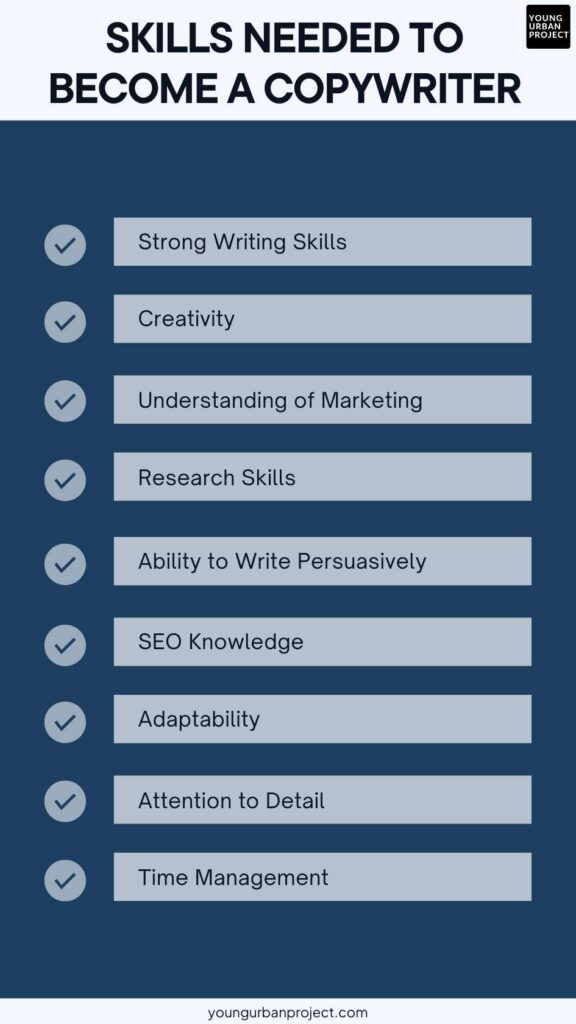
1. Strong Writing Skills
A copywriter must write clearly and persuasively. Their words should be easy to read and understand. Good grammar and spelling are important. Short and direct sentences work best. A copywriter also knows how to make words sound natural and engaging. The goal is to grab attention and keep the reader interested.
2. Creativity
Copywriting is not just about facts; it’s about making words exciting. A copywriter must think of new ways to sell a product or idea. They use humor, storytelling, or emotions to connect with people. Creative writing helps brands stand out. If the copy sounds boring, people won’t pay attention.
3. Understanding of Marketing
Copywriters need to know how marketing works. They must understand what makes people buy things. They study customer behavior and trends. Knowing about branding, advertising, and sales helps them write better. Their words should match the company’s goals and attract the right audience.
4. Research Skills
Good copy comes from good research. A copywriter must learn about the product, the audience, and the competition. They find out what customers like and what problems they have. Reading reviews, studying trends, and checking successful ads can help. The more insight they have, the better they can express themselves in writing.
5. Ability to Write Persuasively
Copywriting is about convincing people. A copywriter must use the right words to make people take action. They create urgency, excitement, or trust through their writing. They highlight the benefits of a product, not just its features. A strong call to action tells readers exactly what to do next.
6. SEO Knowledge
Many copywriters write for websites. They must know how to use keywords to rank higher on search engines. SEO (Search Engine Optimization) helps more people find their content. A copywriter needs to write in a way that pleases both search engines and human readers. This increases traffic and engagement.
7. Adaptability
Copywriters write for different industries and audiences. They must change their tone and style depending on the brand and platform. Writing for social media is different from writing for email marketing. A good copywriter can adjust quickly. They must also keep learning because trends change often.
8. Attention to Detail
Small mistakes can ruin good copy. A copywriter must check their work carefully. Typos, unclear messages, or wrong information can hurt a brand’s image. Proofreading and editing are important. Even small changes, like replacing one word, can make a big difference in how people respond.
9. Time Management
Copywriters often have tight deadlines. They must plan their work and deliver it on time. Organizing tasks and avoiding distractions is important. Many copywriters work on multiple projects at once, so they need to balance their time well. Good time management helps them stay productive and stress-free.
How to Become a Copywriter in 7 Steps
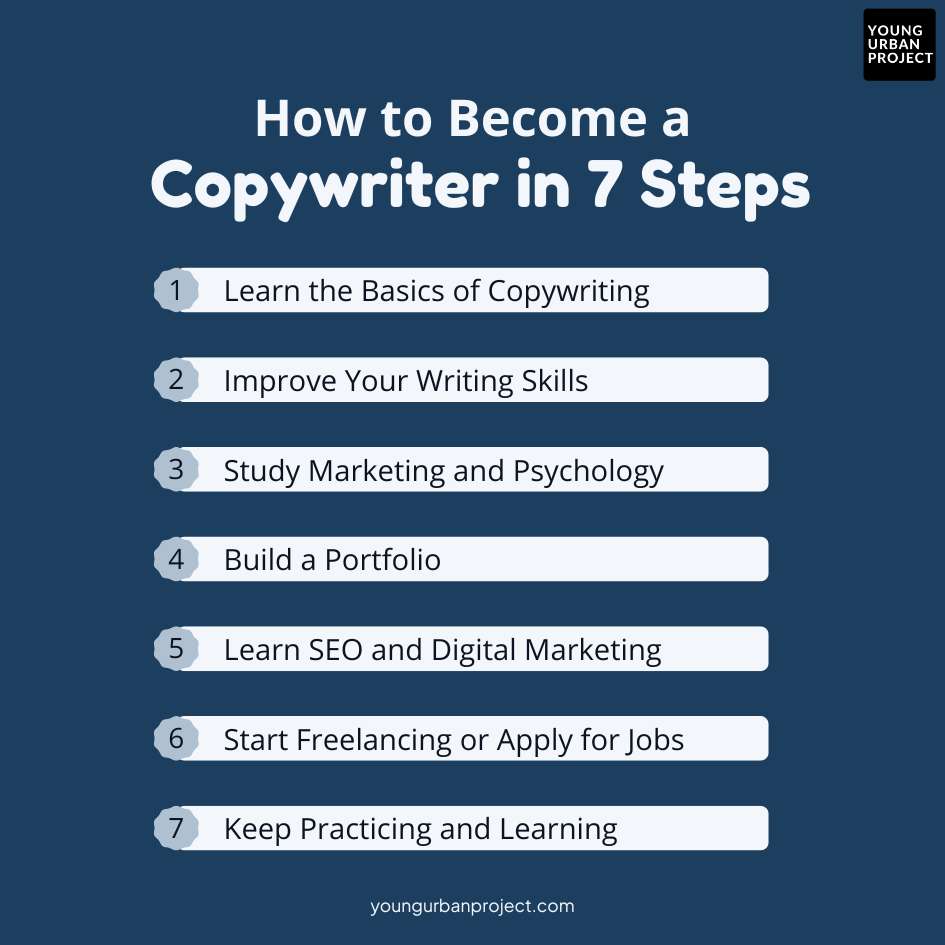
1. Learn the Basics of Copywriting
Start by understanding what copywriting is. Read about how words can sell products and services. Study ads, websites, and social media posts. Notice how brands use words to grab attention. Learn about persuasive writing and how to make people take action. The more you read and observe, the better you will understand copywriting.
Do you want to master copywriting from A to Z, along with powerful psychological frameworks that drive user action? Check out our Ultimate Copywriting Mastery Course and get a high-paying job! No prior experience needed!
2. Improve Your Writing Skills
Good copywriting is clear, simple, and engaging. Practice writing every day. Rewrite ads or create your own product descriptions. Avoid long sentences and complicated words. Use strong and direct language. Read books and blogs about writing. Keep learning new ways to improve. The more you write, the stronger your writing skills grow.
3. Study Marketing and Psychology
Copywriting is about convincing people. Learn how marketing works and what makes people buy things. Study customer emotions and behavior. Understand what grabs attention and what builds trust. Knowing marketing and psychology will help you write words that connect with people and make them take action.
4. Build a Portfolio
A portfolio shows your writing skills to clients or employers. Create sample ads, emails, and product descriptions. If you don’t have real projects, write for imaginary brands. You can also offer free work to small businesses or nonprofits. A strong portfolio helps you get paid jobs. Make sure your best work is included.
5. Learn SEO and Digital Marketing
Many copywriting jobs are online. Learn about SEO (Search Engine Optimization) so your writing ranks on Google. Understand how digital marketing works. Study email marketing, social media ads, and landing pages. Knowing these skills will make you a better copywriter and increase your chances of getting work.
6. Start Freelancing or Apply for Jobs
Once you have a portfolio, start looking for work. Apply for copywriting jobs in companies or agencies. If you want to work for yourself, try freelancing. Websites like Upwork, Fiverr, and LinkedIn can help you find clients. Be patient and keep improving your skills. Smaller jobs can open the door to larger opportunities.
7. Keep Practicing and Learning
Copywriting trends change over time. Keep reading, writing, and learning new skills. Take online courses, follow expert copywriters, and analyze successful ads. The best copywriters never stop improving. The more effort you put into practicing, the better your writing becomes. With time and effort, you can build a successful career in copywriting.
Conclusion
Copywriting is an important skill in digital marketing and content marketing. It helps businesses sell their product or service, build brand awareness, and connect with their target audience. A good copywriter knows how to write words that make people take action, whether it’s buying something, signing up for a newsletter, or clicking a link.
There are different types of copywriting, like SEO copywriting, email marketing, and technical copywriting. Each type has its own purpose, but all focus on creating a strong message. To become a freelance copywriter or work in a company, you need strong writing skills, research skills, and an understanding of search engine optimization (SEO).
Whether you’re writing for a landing page, a marketing campaign, or social media posts, the goal is to create good copy that persuades and engages. By practicing and improving your copywriting skills, you can build a successful career in this field.
FAQs
1. What does copywriting mean? Can you give an example?
Copywriting is writing words that sell a product or service or make people take action. It is used in ads, websites, emails, and social media. A famous example is Nike’s slogan “Just Do It.” This short phrase is powerful, memorable, and encourages people to take action, making it a great piece of copywriting.
2. How can a beginner learn copywriting?
A beginner can start by reading ads, blogs, and sales pages to understand how brands write good copy. Practicing by rewriting ads or creating sample content helps. Learning about SEO copywriting,marketing materials, and persuasive writing is also important. Taking online courses and studying search engine optimization (SEO) can improve skills. With practice, beginners can become freelance copywriters or work for companies.
3. What skills do you need for copywriting?
A good copywriter needs writing skills, creativity, and research skills. They should understand SEO copywriting, email marketing, and marketing campaigns. Knowing how to write copy that is clear, engaging, and persuasive is key. Attention to detail and the ability to format content properly also help. Strong copywriting skills make the message more powerful.
4. How is copywriting different from copyediting?
Copywriting is about writing words that persuade, sell, or promote a product or service. It focuses on making people take action, like buying something or signing up for a newsletter. Copyediting, on the other hand, is about checking grammar, spelling, and clarity in written content. It improves good copy by making it clear and error-free, but it does not create the message.

